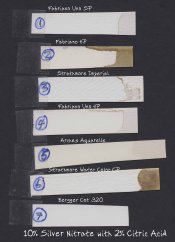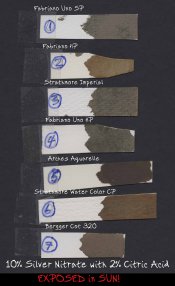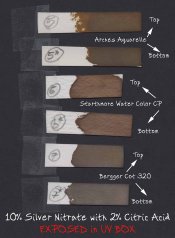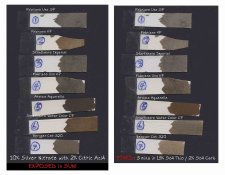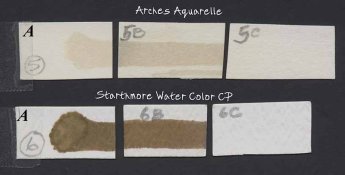Yep...my money will be on the sizing. Sulfur compounds will make sense for the dark stain - that would be akin to toning where you get silver sulfide (or some other variations) as a result. Most paper makers have their own proprietary brew for sizing so the paper dependence is not a surprise. Additionally this reaction of silver nitrate with sizing compounds must like alkaline environment. Hence acidifying the sensitizer and/or pre-acidifying the paper seem to eliminate or reduce it.
As far as I know Cot 320 is gelatin sized, but designed for alt processes as it is, they must use a good quality low-sulfur gelatin.
Edit: No I was wrong about Cot 320. It is not sized with gelatin, but gum arabic - per Christopher James' book. Perhaps that makes the difference.
Someone could have made some money off my bet.
After thinking that perhaps there was some sulfurous toning-like reaction going on between silver nitrate and components of the paper, I wondered if it can be tested if the stains were indeed some silver based compound or metallic silver. To do this I used 1% potassium ferr
icyanide solution to treat the paper (previously coated with AgNO
3 and dried in dark.) If the stains were made of silver metal they should be bleached out by the typical reaction (a la Farmer's reducer):
Ag + K Ferr
icyanide = Ag Ferr
ocyanide (white solid)+ K Ferr
ocyanide (soluble)
But before that I had to remove the excess AgNo
3 as it will also react with K ferr
icyanide to form orange-brown Ag ferr
icyanide, messing up the experiment. For that a couple of distilled water rinses followed by a 1% NaCl soak made sure that all of the AgNo3 was either removed or converted to silver chloride.
The results are shown on the attached jpeg for two papers, #5 = Arches Aquarelle and #6 = Strathmore Watercolor CP, the former showing faint
dark staining and the latter very strong.
A's are control - untreated stains
C's are A's + (pre-rinses + bleach + hypo fix to remove Ag ferrocyanide + final wash) sequence
B's are A's + wash only
Observations:
1. C's are completely clear indicating that the stains are indeed metallic silver and not some AgSx like compounds, as they would be non-reactive towards potassium ferr
icyanide, as I had conjectured.
2. B's got a little darker for #5, but lighter for #6. Don't know what to conclude except just plain water treatment does something to the image.
Now the question is what is going on when silver nitrate meets the paper.
If there is indeed metallic silver in the paper without any UV exposure, it must be a result of spontaneous reduction of silver nitrate - leading to the possibility that the paper is acting like a reducing agent in the manner of a developer.
After some digging, I learned that cellulose can act as a reducing agent, particularly if it has been oxidized to form aldehydes, acids etc. - not an unlikely outcome of the paper making process. Incidentally, glucose, which is the repeating unit of cellulose, was used as a developer at some point in the early history. Furthermore, the reducing action is catalyzed or helped in alkaline conditions. This explains the greater propensity of the buffered papers for stains and elimination of the same by pre-acification.
The other reducing source could be the sizing agent. AgNo
3 is a very prominently used as a "stain" for protein molecules as a way to boost the electron density of specimens for electron microscopy. There are plenty of proteins in the gelatin and other sizing agents.
Comments/observations/caveats welcome. Feel free to poke holes....there are bound to be some!
:Niranjan.


